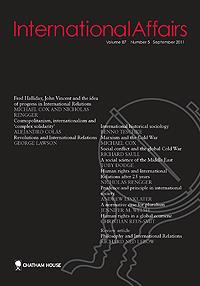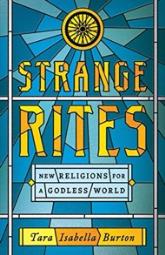

![]() Last month, we neglected to mention an important special issue of the journal International Affairs (March, 2020) devoted to the interaction between international relations and the discipline of religious studies. It is not as arcane as it sounds, with editor Katherine Brown writing in the introduction to the issue that “we cannot understand international affairs without understanding religion and also that we cannot understand religion without understanding international affairs.” But Brown adds that the actual research on the interaction between the two fields in the has generated a paltry 72 articles with religion as the main subject since the flagship journal began in 1922. Fifty-two of these articles focus on Islam, with just 7 on Christianity 4 on Hinduism and none on Buddhism. In redressing this poor track record, the issue pays special attention to groups and movements considered marginal, including articles on the role of women in the Islamic State, the prospects of “post-secular counter-terrorism” in dealing with the IS, and how engagement with faith-based environmental activism can be effective by taking the theology of its participants seriously. For more information on this issue, visit: https://academic.oup.com/ia
Last month, we neglected to mention an important special issue of the journal International Affairs (March, 2020) devoted to the interaction between international relations and the discipline of religious studies. It is not as arcane as it sounds, with editor Katherine Brown writing in the introduction to the issue that “we cannot understand international affairs without understanding religion and also that we cannot understand religion without understanding international affairs.” But Brown adds that the actual research on the interaction between the two fields in the has generated a paltry 72 articles with religion as the main subject since the flagship journal began in 1922. Fifty-two of these articles focus on Islam, with just 7 on Christianity 4 on Hinduism and none on Buddhism. In redressing this poor track record, the issue pays special attention to groups and movements considered marginal, including articles on the role of women in the Islamic State, the prospects of “post-secular counter-terrorism” in dealing with the IS, and how engagement with faith-based environmental activism can be effective by taking the theology of its participants seriously. For more information on this issue, visit: https://academic.oup.com/ia

![]() Strange Rites (Public Affairs, $16.99), by Tara Isabella Burton, is a valuable book that shines a bright light on the underside of American religion and spirituality, even if their “godless” proponents and participants may not always recognize them as such. The culturally conversant Burton offers the reader in-depth “participant observation” in the lifestyles, beliefs, half-beliefs, and doubts as well as the often experimental and “remixed” rituals, practices, and new forms of community in the growing population of the non-affiliated. Burton acknowledges that the “nones” are a diverse population, with many holding conventional beliefs, if not practices, and others increasingly non-religious and non-spiritual, but she tends to focus on the “spiritual fluidity” and mix-and-match quality of one segment of this unwieldy group (which can also include believers affiliated with particular religions) Thus, Burton estimates that at least half of all Americans may be “remixed.” As other studies of “spiritual-but-not-religious” Americans have shown, many have a free-floating spirituality and sense of the transcendent that they attach to a wide range of activities that they claim as the most authentic to their lives.
Strange Rites (Public Affairs, $16.99), by Tara Isabella Burton, is a valuable book that shines a bright light on the underside of American religion and spirituality, even if their “godless” proponents and participants may not always recognize them as such. The culturally conversant Burton offers the reader in-depth “participant observation” in the lifestyles, beliefs, half-beliefs, and doubts as well as the often experimental and “remixed” rituals, practices, and new forms of community in the growing population of the non-affiliated. Burton acknowledges that the “nones” are a diverse population, with many holding conventional beliefs, if not practices, and others increasingly non-religious and non-spiritual, but she tends to focus on the “spiritual fluidity” and mix-and-match quality of one segment of this unwieldy group (which can also include believers affiliated with particular religions) Thus, Burton estimates that at least half of all Americans may be “remixed.” As other studies of “spiritual-but-not-religious” Americans have shown, many have a free-floating spirituality and sense of the transcendent that they attach to a wide range of activities that they claim as the most authentic to their lives.
Through an interesting detour through American religious history, Burton shows that all of this remixing is not necessarily something brand new, although social media has intensified it.. The book is most informative in teasing out (sometimes reading like a dizzying catalog of a whole era) the subtle shades of spirituality and even actual religion in the secular and not-so secular environs of Soulcycle, Jediism, video games, the Satanic Temple, the alt-right, Jordan Peterson, Black Lives Matters activism, safe spaces, transhumanism, utopian kink and polyamorous relationships, political magic and witchcraft, social justice warriors, Gwyneth Paltrow’s Goop and the idea of “self-care,” Harry Potter fandom (which, in fact, has influenced many of these new spiritual/religious expressions), performance art, and most of all, consumerism and the branding of spirituality.
Although these new forms may not provide the meanings, rituals, and community of traditional religions, their remixed quality doesn’t necessarily demand such “one-stop-shopping”; for instance, one can have the need for rituals provided yoga and the need for meaning provided by political activism. Burton notes that the multiplicity of these new religious forms obviously reflects and intensifies the fragmentation of modern life, especially as people sort themselves out into like-minded tribes (electrified by fan culture). Where all this ferment is leading (especially in the wake of a global pandemic and what has been called a new “cultural revolution” stemming from the protests, all of which took place right after this book was in the galleys), is anyone’s guess. But the reader can only admire the lengths Burton goes to make sense of this chaotic and quite unsecular brave new world.